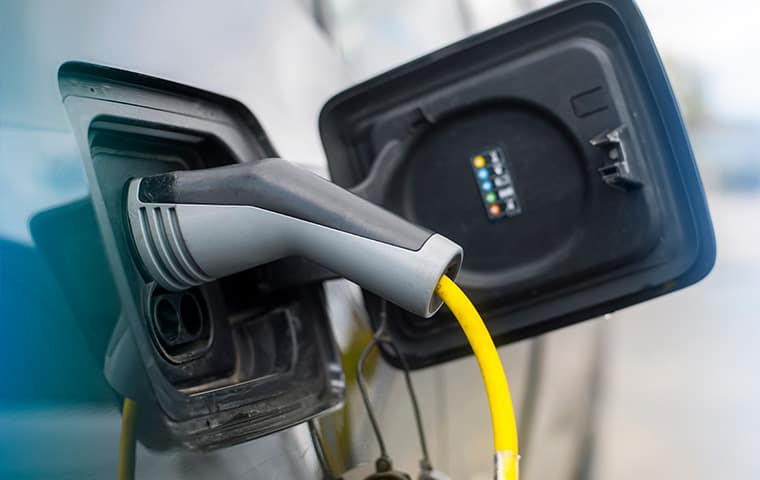Your fleet has used diesel or gasoline-powered vehicles since the very beginning. When considering switching your fleet's power source, it’s completely natural to feel a bit apprehensive about such a monumental change for your company.
Many fleets have already gone through the fleet electrification process, thus paving the way for others to learn how to embrace sustainability within their fleets.
If you’ve been considering fleet electrification as an option for your business, read on for everything you need to know about making the switch and cutting back on your emissions.
Fleet Electrification Defined
What is fleet electrification anyway? Fleet electrification means replacing your fleet of ICE (internal combustion engine) vehicles and replacing them with sustainable battery-powered vehicles. While going through the fleet electrification process, your fleet may experience several logistical challenges. This will vary depending on your industry, the area you operate in, and the overall size of your fleet.
Why Fleet Electrification
There are a couple reasons why many fleets have made the transition to electric-powered vehicles. Offering an array of benefits for early adopters, fleet electrification is the way of the future for many fleets. Here are some of the reasons why fleets opt for making the change.
Sustainability Benefits
Your drivers are on the road every day working hard to service your area and industry in a quality and timely manner. ICE vehicles are also releasing carbon emissions into the atmosphere that add up over time while your fleet drivers are on the road. And across your entire fleet, these emissions add up fast! The environmental impacts are obvious for big and small fleets alike. As our country moves toward green energy and sustainability practices, early adoption of such technologies looks good to your clients and is generally a good business practice.
Long Term Savings for Your Fleet
While the environmental impacts could be enough of a benefit, the good news as a business owner is that sustainability pays off in the long run. One of the greatest costs for your fleet business is how much diesel or gasoline costs your drivers. Imagine that your business wasn’t victim to rising fuel costs or even had to worry about fuel costs for that matter! While the initial investment in the new greener technologies might give some fleets sticker shock, it’s important to keep in mind there is a reason many fleets have already gone through the fleet electrification process. Savings over the years is one of the most significant factors to why these businesses opt to make the change.
Challenges to Overcome While Switching to Electric Powered Vehicles
Change isn’t without its challenges, of course. While each fleet making this change will experience a unique set of challenges depending on their business, below are some of the most common challenges shared by fleets who went through the fleet electrification steps.
Initial Cost
We mentioned earlier the sticker shock some fleet managers might experience when pricing out new electric vehicles compared to ICE options on the market. There’s no denying that electric vehicles are the most expensive out of these options. When faced with this initial cost keep in mind these things:
- Research government subsidies and rebate options that reward businesses for making sustainable choices, such as purchasing electric vehicles.
- Electric vehicles, while having an upfront cost, don’t need the more expensive fuel option in the long run offering long term savings for the fleet businesses that operate using this technology.
When looking at the initial costs, make sure to look at the full picture and research what programs your fleet business can apply for.
Needed Infrastructure
Depending on your service area, you may or may not need to consider where your fleet will charge. Electric vehicles are growing in popularity, but different parts of the country are adopting this technology faster than others. You might be operating in an area where charging stations are easy to find for your drivers, or they might be few and far between if they are even there at all. When considering fleet electrification, determine whether your business will need the infrastructure for charging. If there are no locations for your fleet to charge nearby, you might need to consider adding one on-site.
As electric vehicles continue to be added to the road, fuel charging stations will pop up as well. If you’re waiting until this technology gets more popular in your area, keep an eye out for new charging stations in your service area.
Needed Training for Drivers
At the end of the day, those who will be most impacted by your decision to switch to electric vehicles are the men and women driving the trucks for your fleet. Make sure that your drivers understand how and where they are expected to charge these new vehicles. Will they be charging them on their route or on-site at one of the charging stations your business built?
Also, keep in mind that for many of these drivers, this might be their first time operating this kind of vehicle. Be sure to field any of the questions or concerns so that they feel comfortable charging and driving your new vehicles.
Fleet Electrification: The Way of the Future
As fleet managers, it’s important to focus on the road ahead. Undoubtedly, electric vehicles will continue to grow in popularity in the coming years as our country advocates for sustainable business practices. Fleet electrification ensures that your business stays up to date with the latest technology on the market. While also lessening the environmental impact your business will have on your community.
Your team deserves the best technology to help make their jobs easier and less stressful. Having end-to-end software for your fleet is another way to ensure you have the best technology on your side. Learn how our products can help service your fleet and support your drivers when you schedule a demo or contact us.








